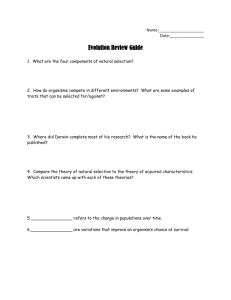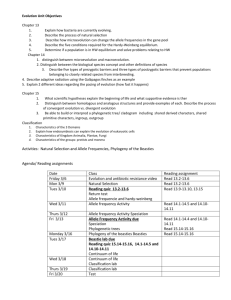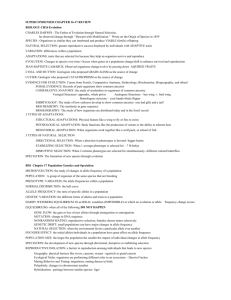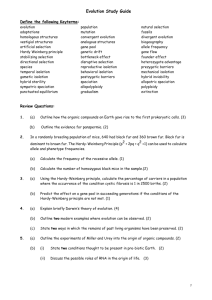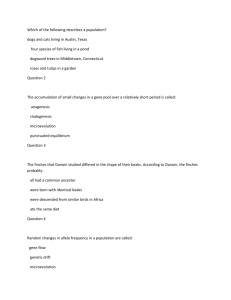Practicing Biology Name: Based on his observations and inferences
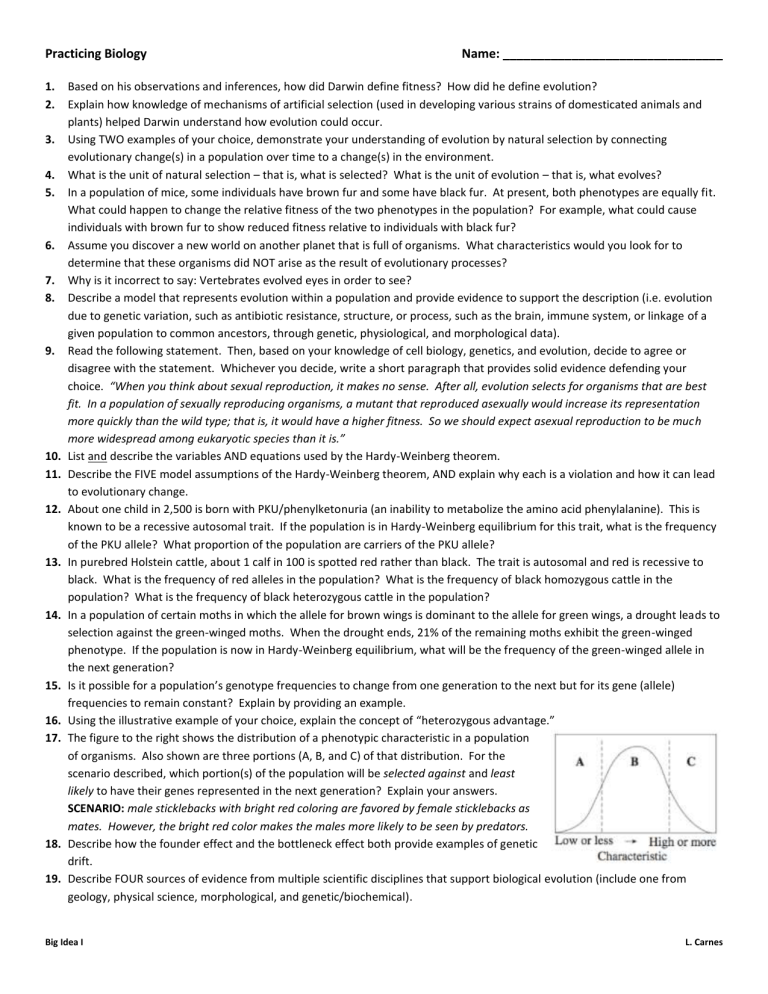
Practicing Biology Name: ________________________________
1.
Based on his observations and inferences, how did Darwin define fitness? How did he define evolution?
2.
Explain how knowledge of mechanisms of artificial selection (used in developing various strains of domesticated animals and plants) helped Darwin understand how evolution could occur.
3.
Using TWO examples of your choice, demonstrate your understanding of evolution by natural selection by connecting evolutionary change(s) in a population over time to a change(s) in the environment.
4.
What is the unit of natural selection – that is, what is selected? What is the unit of evolution – that is, what evolves?
5.
In a population of mice, some individuals have brown fur and some have black fur. At present, both phenotypes are equally fit.
What could happen to change the relative fitness of the two phenotypes in the population? For example, what could cause individuals with brown fur to show reduced fitness relative to individuals with black fur?
6.
Assume you discover a new world on another planet that is full of organisms. What characteristics would you look for to determine that these organisms did NOT arise as the result of evolutionary processes?
7.
Why is it incorrect to say: Vertebrates evolved eyes in order to see?
8.
Describe a model that represents evolution within a population and provide evidence to support the description (i.e. evolution due to genetic variation, such as antibiotic resistance, structure, or process, such as the brain, immune system, or linkage of a given population to common ancestors, through genetic, physiological, and morphological data).
9.
Read the following statement. Then, based on your knowledge of cell biology, genetics, and evolution, decide to agree or disagree with the statement. Whichever you decide, write a short paragraph that provides solid evidence defending your choice. “When you think about sexual reproduction, it makes no sense. After all, evolution selects for organisms that are best fit. In a population of sexually reproducing organisms, a mutant that reproduced asexually would increase its representation more quickly than the wild type; that is, it would have a higher fitness. So we should expect asexual reproduction to be much
more widespread among eukaryotic species than it is.”
10.
List and describe the variables AND equations used by the Hardy-Weinberg theorem.
11.
Describe the FIVE model assumptions of the Hardy-Weinberg theorem, AND explain why each is a violation and how it can lead to evolutionary change.
12.
About one child in 2,500 is born with PKU/phenylketonuria (an inability to metabolize the amino acid phenylalanine). This is known to be a recessive autosomal trait. If the population is in Hardy-Weinberg equilibrium for this trait, what is the frequency of the PKU allele? What proportion of the population are carriers of the PKU allele?
13.
In purebred Holstein cattle, about 1 calf in 100 is spotted red rather than black. The trait is autosomal and red is recessive to black. What is the frequency of red alleles in the population? What is the frequency of black homozygous cattle in the population? What is the frequency of black heterozygous cattle in the population?
14.
In a population of certain moths in which the allele for brown wings is dominant to the allele for green wings, a drought leads to selection against the green-winged moths. When the drought ends, 21% of the remaining moths exhibit the green-winged phenotype. If the population is now in Hardy-Weinberg equilibrium, what will be the frequency of the green-winged allele in the next generation?
15.
Is it possible for a population’s genotype frequencies to change from one generation to the next but for its gene (allele) frequencies to remain constant? Explain by providing an example.
16.
Using the illustrative example of your choice, explain the concept of “heterozygous advantage.”
17.
The figure to the right shows the distribution of a phenotypic characteristic in a population of organisms. Also shown are three portions (A, B, and C) of that distribution. For the scenario described, which portion(s) of the population will be selected against and least
likely to have their genes represented in the next generation? Explain your answers.
SCENARIO: male sticklebacks with bright red coloring are favored by female sticklebacks as mates. However, the bright red color makes the males more likely to be seen by predators.
18.
Describe how the founder effect and the bottleneck effect both provide examples of genetic drift.
19.
Describe FOUR sources of evidence from multiple scientific disciplines that support biological evolution (include one from geology, physical science, morphological, and genetic/biochemical).
Big Idea I L. Carnes
20.
Describe TWO sets of conserved features and core processes shared within AND between domains of life that support the concept of a common ancestry for all life.
21.
Perform an outgroup comparison on the organisms listed in the data table to the right. Construct a phylogenetic tree that represents the evolutionary relationships that exist between these organisms. Explain how this phylogenetic tree is a representation/model that reflects ancestral differences AND similarities.
22.
Considering only the individual representative organisms in the phylogenetic tree below (i.e. bird, whale, frog, etc.), which can be used as a good example of analogy/convergent evolution? As good examples of homology? Explain your reasoning.
23.
When phylogenies are developed using DNA sequence analysis, they may differ from those constructed using morphology and physiology. How do scientists know which method is more correct? Explain.
24.
Using the five major extinctions as an illustrative example, explain why extinction rates are rapid at times of ecological stress.
25.
If you wanted to address questions related to reproductive isolation and speciation, what data would you collect to determine if a particular mating barrier is pre or post-zygotic? Justify your choice.
26.
If you wanted to address questions related to reproductive isolation and speciation, what data would you collect to determine if speciation is allopatric or sympatric? Justify your choice.
27.
Many of our most successful grain crops arose as hybrids; most are also allopolyploids. These crops can successfully reproduce.
Explain.
28.
Using the illustrative example of your choice, describe a model that supports the idea that populations of organisms continue to evolve.
29.
Describe how the rise and fall of dominant groups reflect continental drift, mass extinctions, and adaptive radiations.
30.
Describe several models about the origins of life on Earth (i.e. Oparin-Haldane organic soup model, solid reactive surface model, etc.), explain reasons for revisions of hypotheses based on new scientific evidence from different disciplines (i.e. “RNA World,” early atmosphere neither reducing nor oxidizing, origin of life in deep-sea vents, submerged volcanoes), and explain limitations of the various models, such as laboratory conditions simulating conditions on primitive Earth.
